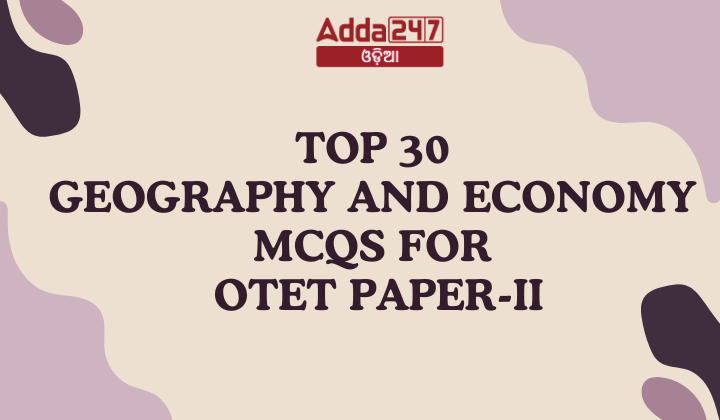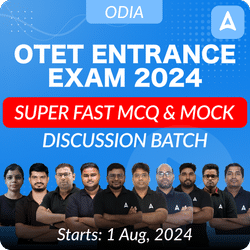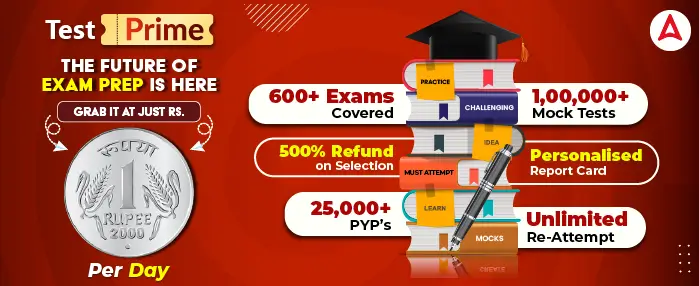Preparing for the OTET (Odisha Teacher Eligibility Test) Paper-II can be a daunting task, especially when it comes to subjects like Geography and Economy. To help you with your preparation, we’ve compiled a list of the top 30 multiple-choice questions (MCQs) that cover essential topics in both Geography and Economy. These questions are designed to test your knowledge and ensure you’re ready for the exam.
Top 30 Geography and Economy MCQS For OTET Paper-II Exam
- Which region of Odisha is known as the “Rice Bowl” of the state due to its fertility?
A) The Odisha Coastal Plains in the East
B) The Middle Mountainous and Highlands Region
C) The Central Plateaus
D) The Western Rolling Uplands
Answer: A) The Odisha Coastal Plains in the East - Which of the following regions in Odisha is the most drought-affected area?
A) Northern Coastal Plains/Balasore Plains
B) Middle Coastal Plains/Cuttack-Puri Coastal Plain
C) Southern Coastal Plains/Rushikulya Plains
D) The Salt Tract
Answer: A) Northern Coastal Plains/Balasore Plains - Which mountain range in Odisha is the highest in the state and is home to the Deomali peak, the highest peak of Odisha?
A) Simlipal and Meghasani Mountains
B) Mankadnacha, Malayagiri, and Gandhamardan Mountains
C) Common Interfluves of the Mahanadi, the Rushikulya, and Vamsadhara
D) Potangi and Chandragiri Mountain Ranges
Answer: D) Potangi and Chandragiri Mountain Ranges - Which plateau in Odisha lies on the Western slopes of the Eastern Ghats and is surrounded by the Singhbhum and Ranchi plateaus in the North?
A) The Panposh-Keonjhar-Pallahara Plateau of the Upper Baitarani Catchment Basin
B) The Nabarangpur-Jayapur of the Upper Sabari Basin
C) The Rajgangpur-Panposh uplands of the Koel and the Sankh rivers
D) The Jharsuguda uplands of the Ib basin
Answer: A) The Panposh-Keonjhar-Pallahara Plateau of the Upper Baitarani Catchment Basin - What is the average elevation range of the River Valleys and Flood Plains in Odisha?
A) 200 to 400 meters
B) 75 to 150 meters
C) 500 to 800 meters
D) 1000 to 1200 meters
Answer: B) 75 to 150 meters - Which lake in Odisha is the deepest natural port of India?
A) Ansupa Lake
B) Sar Lake
C) Chilika Lake
D) Paradeep Port
Answer: D) Paradeep Port - What is the major river that drains the Rajgangpur-Panposh uplands of Odisha?
A) Mahanadi River
B) Brahmani River
C) Sabari River
D) Vamsadhara River
Answer: B) Brahmani River - Which region of Odisha is known for its volcanic origin mountains with dome-shaped and circular structure?
A) Simlipal and Meghasani Mountains
B) Mankadnacha, Malayagiri, and Gandhamardan Mountains
C) Potangi and Chandragiri Mountain Ranges
D) Singaraju, Mahandragiri, and Devagiri Mountain Ranges
Answer: A) Simlipal and Meghasani Mountains - During which season does Odisha experience the highest temperatures, often exceeding 40°C?
A) Rainy Season
B) Winter Season
C) Summer Season
D) Autumn Season
Answer: C) Summer Season - What is the primary cause of rainfall in Odisha during the monsoon season?
A) Western Disturbances
B) Northeast Monsoon
C) Southwest Monsoon
D) Tropical Cyclones
Answer: C) Southwest Monsoon - Which regions of Odisha are characterized by low annual rainfall, typically 135 cm or less?
A) Northern Odisha
B) South-East Odisha
C) Western Odisha
D) Coastal Odisha
Answer: B) South-East Odisha - What is the approximate range of relative humidity experienced in coastal Odisha during the monsoon season?
A) 40% – 50%
B) 60% – 70%
C) 75% – 85%
D) 90% – 100%
Answer: C) 75% – 85% - Which season in Odisha experiences thunder showers in the Southern and Western parts of the state?
A) Summer Season
B) Rainy Season
C) Winter Season
D) Spring Season
Answer: C) Winter Season - What is the local seasonal division in Odisha that corresponds to mid-February to mid-April?
A) Grishma (Summer)
B) Barsa (Rainy season)
C) Basanta (Spring)
D) Sisira (Winter)
Answer: C) Basanta (Spring) - Which climate classification system categorizes Odisha’s climate as tropical savannah type?
A) Koppen’s classification
B) Thornthwaite’s classification
C) SB Chatterjee’s classification
D) Bergeron classification
Answer: A) Koppen’s classification - What do you mean by the supply of goods?
a) Stock available for sale
b) Total stock in the warehouse
c) The actual production of the goods
d) Quantity of the goods offered for sale at a particular price per unit of time
Answer: d - What do you mean by ‘under conditions of a perfect competition in the product market’?
a) MRP = VMP
b) MRP > VMP
c) VMP > MRP
d) None of the above
Answer: a - What do you mean by a mixed economy?
a) Modern and traditional industries
b) Public and private sectors
c) Foreign and domestic investments
d) Commercial and subsistence farming
Answer: b - What do you mean by the demand of a commodity?
a) Desire for the commodity
b) Need for the commodity
c) Quantity demanded of that commodity
d) Quantity that consumers are able and willing to buy at various prices during any particular period of time
Answer: d - What do you mean by Gross National Product?
a) The total value of goods and services produced in the country
b) The total value of all the transactions in the country
c) The depreciation in the total value of goods and services produced in the country
d) The total value of goods and services produced in the country and the net factor income from abroad
Answer: d - Which of the following is the reason for the decline in the child sex ratio in India?
a) Low fertility rate.
b) Female foeticide
c) Incentives for a boy child from the government
d) None of the above
Answer: b - What factors are taken into consideration while revising the poverty line periodically?
a) By conducting a survey every five years
b) Survey carried out by National Sample Survey Organisation
c) Both a and b
d) None of the above
Answer: c - In India, which banks/institutions have the highest share in the disbursement of credit to agriculture and allied activities?
a) Cooperative banks
b) Regional Rural Banks
c) Commercial banks
d) Microfinance institutions
Answer: c - Which of the following is/are linked with the financial sector of India and controlled by the Reserve Bank of India (RBI)?
a) Commercial bank
b) Money lenders
c) Stock exchange operations
d) All of the above
Answer: c - When price floor is set above equilibrium price it will result in?
a) Shortage
b) Surpluses
c) Equilibrium
d) None of the above
Answer: b - What is Gross Domestic Product?
a) The total value of goods and services manufactured in the country
b) The total value of all the transactions in the country
c) The reduction in the total value of goods and services produced in the country
d) The monetary value of all finished goods and services made within a country during a specific period.
Answer: d - What does the bowed-out shape of the production possibilities curve illustrate?
a) Law of increasing opportunity cost
b) The production is inefficient
c) The production is unattainable
d) The demand is relatively elastic
Answer: a - What is the main economic problem faced by the society?
a) Unemployment
b) Inequality
c) Poverty
d) Scarcity
Answer: d - What does “Capitalism” refer to?
a) The use of market
b) Government ownership of capital
c) Private ownership of capital goods
d) Private ownership of homes and cars
Answer: c - The goal of a pure market economy is to meet the desire of ______.
a) Consumers
b) Copanies
c) Workers
d) The government
Answer: a










